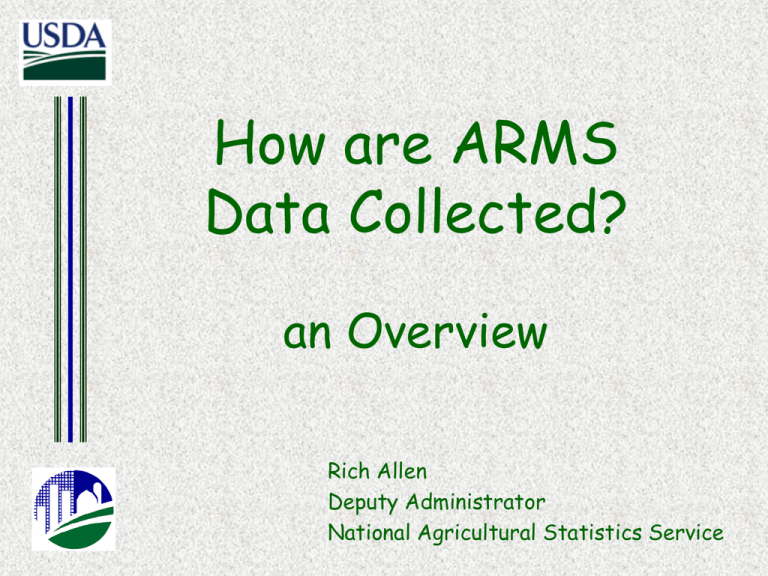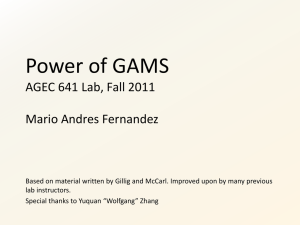Rich Allen, National Agricultural Statistics Service
advertisement

How are ARMS Data Collected? an Overview Rich Allen Deputy Administrator National Agricultural Statistics Service Goals • • • • • • Clarify survey content Describe data interrelationships Outline sampling approach Mention publicity approaches Highlight data collection concerns Touch on analysis/summary Farm Production Expenditures Survey 1972 - 1984 Cost of Production Surveys 1973 - 1984 Farm Costs and Returns Survey 1985 - 1995 Cropping Practices Survey 1990 - 1995 Agricultural Resource Management Survey 1996 – 2??? Multiple phases are used for survey efficiency, timeliness, and data linkages ARMS Phase I • Conducted between May and July to screen farms for the later phases • Ensures operations are still in business • Defines the sampling frame for later phases • Shortens initial contact (average 5-10 minutes) • Collects general farm data such as crops grown, livestock inventory, and value of sales ARMS Phase II • Conducted from September through December when information should be fresh • Collects data on chemical usage, production practices, resource use, and variable costs of production for specific commodities • Shortens interview by focusing on specific commodities (3-year average – 60 Minutes) ARMS Phase III • Conducted from February through April when records should be complete • Collects information on whole farm finance, operator, and household characteristics • Uses multiple questionnaire versions • Requires a considerable amount of time (3-year average – 94 minutes) Cost of Production Matrix 1 Year Commodities 2000 Dairy, Rice, Sugar beets 2001 Corn 2002 Soybeans 2003 Barley, Upland Cotton, Sorghum 2004 Peanuts, Durum Wheat, Other Spring Wheat, Winter Wheat, Hogs Cost of Production Matrix 2 Year Commodities 2005 Corn, Dairy, Oats 2006 Soybeans, Poultry 2007 Upland Cotton, Rice 2003 ARMS II Sample Sizes Commodity Samples Barley 2,133 Sorghum 1,433 Cotton 2,559 Positive responses from Phase II move to Phase III. 2003 ARMS III Typical Versions Version Cost & Returns Report Samples 12,375 Barley PPCR 2,133 Sorghum PPCR 1,433 Cotton PPCR 2,559 Subtotal 18,500 (Core – 15 states – 16,850) Chem Use Matrix 1 Year Commodities 2000 Corn, Upland Cotton, Soybeans, Durum Wheat, Other Spring Wheat, Winter Wheat Upland Cotton, Soybeans, Fall Potatoes Corn, Durum Wheat Wheat, Other Spring Wheat, Winter Wheat 2001 2002 Chem Use Matrix 2 Year Commodities 2003 Corn, Fall Potatoes 2004 Soybeans 2005 Upland Cotton, Fall Potatoes Durum Wheat, Other Spring Wheat, Winter Wheat Corn, Fall Potatoes 2006 2007 2003 ARMS III Expansion • New funding provides for increased sample sizes for state level data • A shorter “core” questionnaire has been designed • Two survey modes will be used for initial contacts – Personal – Mail Sample Selection Objectives • Represent all operations • Create detailed data sets • Minimize respondent burden Perry – Burt Sampling • Sample selection weights adjusted for previously selected operations • Approach virtually eliminates chance of selection in consecutive years Stratification • Main variable is economic size class • Sampling rates adjusted for operations selected for commodity specific contacts Data Expansions • Basic weights based on inverse of selection factors • Weights adjusted within strata for missing data Data Edits and Analysis • Records edited for internal consistency • Individual expansions examined for outliers • National and Regional summaries are reviewed Routine ARMS III Uses • Income and expense estimates to BEA - - late June • Farm Production Expenditures Report (NASS) - - mid-July • National Income Estimates (ERS website) - - September • Ag Income and Finance S & O (ERS website) - - November ARMS Data Collection Concerns • • • • Survey seems long Some questions are not farm related Some question seem quite personal Respondents often don’t understand “What’s in it for me?” • Some questions ask for things that can’t be easily answered Past Data Collection Approaches • Strengthen enumerator training • Minimize overlap with other surveys • Send out pre-survey letters • Set up interview appointments • Send back personalized summary information Survey Promotion Approaches • • • • NASS awareness postcards Pre-survey “theme” letters Data user testimonies Promotional brochures Data Collection Help Needed • How to stress “What’s in it for you?” • How to describe state and local data uses




